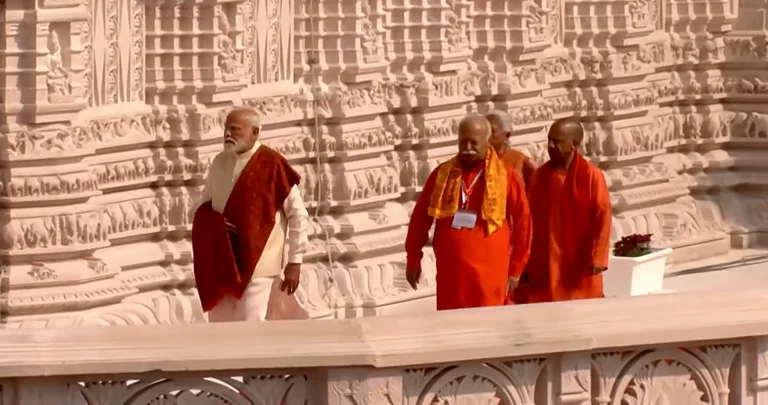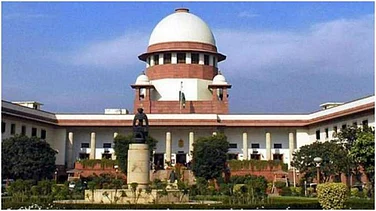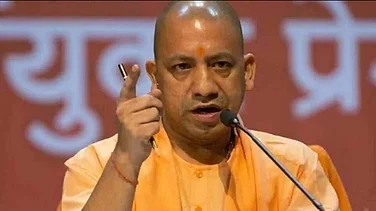Arriving in Ranchi on the evening of March 28, 2023, just before the much-anticipated Ram navami festival slated for March 30, I found the city cloaked in vibrant saffron and yellow hues. Making my way towards my residence near the renowned Tapovan Mandir, the epicentre of Ram navami celebrations in Ranchi, I was greeted by a spectacle of Mahavir Patakas (Hanuman flags) fluttering proudly in the breeze. The streets were adorned with posters depicting the revered figures of Ram, Laxman, Sita, and Hanuman, while decorative lights and ribbons added to the festive ambiance. Notably, the presence of a sizeable police force underscored the city's readiness to prevent any potential communal tensions often associated with the Ram navami procession.
As I neared my neighbourhood, the atmosphere crackled with energy, filled with the rhythmic pulse of drums and fervent chants of 'Jai Shree Ram' echoing in the air. It was the spirited young boys from Khijur Tola, a Scheduled Caste locality near Tapovan Mandir, who were diligently preparing for their participation in the Ram navami procession. Year after year, armed with swords and lathis, they would proudly exhibit their skills while carrying the Mahavir Pataka towards the Tapovan Mandir grounds. Amidst a sea of devoted Rambhakts, the procession crescendoed in Tapovan Mandir grounds, marking the pinnacle of the festival's exuberant celebrations.
Like the vast multitude of around 1800 Akhadas under the Mahavir Mandal, which has orchestrated the Ram navami procession in Ranchi since 1935, the dedicated young men and boys from Khijur Tola undergo rigorous training for over a month to participate in this revered event. Ram navami has undeniably ascended to become one of Ranchi's most politically significant festivals, acting as a potent emblem of Hindu unity and strength, reflecting similar sentiments echoed throughout the country.
Despite the complex demographics of Jharkhand, characterised by a substantial 26.2 per cent ST population and a history of Adivasi politics centred on autonomy and distinct identity, Ram navami celebrations in the state are far from subdued. Cities like Ranchi, Jamshedpur, Hazaribagh, Dhanbad, and Bokaro host Ram navami festivities that match, if not surpass, the fervour seen in North Indian regions. Notably, Hazaribagh’s Ram navami procession lasts an impressive 72 hours, ranking among the country's longest and most significant events, albeit occasionally stirring communal tensions. Furthermore, Ram navami processions have expanded into small towns and rural areas of Jharkhand, highlighting the growing political significance and popularity of Ram and Ram navami. This expansion has prompted the establishment of Mahavir Mandal and Mahavir Akharas across the state, playing crucial roles in organising and overseeing Ram navami celebrations.
Ramnavmi's Socio-Political Journey in Ranchi
Since its inception in 1929, Ram navami processions have wielded significant political influence in Ranchi, particularly against the backdrop of increasing migration of middle and upper caste Hindu communities into Jharkhand during the late colonial and post-colonial eras. This demographic influx was spurred by robust industrialisation, extensive mining activities, burgeoning commercial enterprises, and bureaucratic expansions. Despite the burgeoning migrant Hindu population, their political and economic dominance faced formidable challenges from the Jharkhand movement, which pejoratively labelled the dominant migrant Hindus as "Dikus" or exploitative outsiders. This movement was orchestrated in opposition to the entrenched power structures of these dominant groups.
Within the politically charged realm of Jharkhand, Hindu celebrations like Ramnavmi processions, meticulously orchestrated by Mahavir Mandals, played a central role as platforms for migrant Hindu communities to organize and forge alliances with native Hindu groups, known as Sadan. This collaborative endeavour was geared towards strengthening their political dominance in the region. By dominating public spaces during the processions and saturating the city with Hindu flags, symbols, and chants, they unequivocally asserted their influence. Moreover, the conspicuous display of weaponry during the procession underscored their masculine identity and enhanced their political authority.
The political deployment of festivals by Hindu groups in Jharkhand followed a blueprint established by Hindu nationalists such as BG Tilak in Maharashtra. Amidst escalating communal tensions between Hindus and Muslims during the late colonial and early post-colonial periods, public festivals, notably Ram navami processions, became arenas for demonstrating Hindu solidarity and resilience. Timed around March-April, Ram navami coincided with the Muslim festival of Moharram, igniting competitive exhibitions of strength between the two communities. However, the situation in Jharkhand grew more intricate in the 1980s.
Amidst the religious passions spurred by the Ram Mandir movement led by the Sangh Parivar, Ram navami gained increased prominence. Simultaneously, Adivasi leaders and activists promoted the public celebration of the regional festival of Sarhul, asserting Adivasi and Moolvasi (Native non-tribal) solidarity around the 'Jharkhandi identity'. Massive processions were organised in Jharkhand cities during March-April, amplifying the significance of Sarhul. Sarhul symbolised the strength of the Adivasi-Moolvasi population and promoted the regional Jharkhandi identity, countering attempts by Hindu nationalists to create political solidarity around Hindu religious identity.
Over time, Ram navami has become a vibrant symbol of Hindu solidarity, evolving from a small procession to a grand event in Jharkhand. It provides a platform for showcasing unity amidst the region's complex socio-political dynamics. Originating as a procession led by migrant Hindu groups in Adivasi areas, it has grown into a potent expression of Hindu identity. Its widespread participation, including from Adivasis and Dalits, underscores the region's shifting political landscape and the increasing influence of political Hinduism.
On March 30, 2023, the Ram navami procession witnessed an unprecedented turnout, with thousands flooding the streets, surpassing previous years' attendance. Men dominated the centre of the activity, while women and children observed from the sidelines. Throughout Ranchi, Mahavir flags adorned the city, proudly waving in the breeze.
The procession kicked off at 1:30 pm, stretching into the evening until 10 pm. Participants brandished flags, swords, and daggers, symbolising Hindu strength and unity. The air buzzed with energy as chants of 'Jai Shree Ram' echoed louder than ever. Energetic dancing to EDM tunes, courtesy of DJ sets, heightened the spectacle. Massive Mahavir Phatakas illuminated the scene, enhancing the procession's grandeur. Various Akharas showcased their combat prowess with swords and lathis, injecting a hyper-masculine ambiance into the event.
Chandan, a 22-year-old Adivasi participant, expressed his enthusiasm, stating, "Being part of the procession is exhilarating. You feel empowered, with the police and administration at our service and politicians escorting us. It feels like we have control over the entire city." The majority of participants in the processions hail from humble socio-economic backgrounds, belonging to OBC, SC, and ST groups.
In their daily lives in the city, they frequently experience a lack of power and agency, with their interactions with state institutions often resulting in negative experiences. However, during the religious effervescence of Ram navami, there is a temporary suspension of the established order, allowing them to feel empowered and as though they control the city. However, the power they wield in the crowd is transient, and their involvement ultimately reinforces the existing power structures, empowering dominant caste members who manage the festivals and occupy leadership positions in cultural and political organisations in the region.
The Political Significance of Ram navami Amidst Electoral Dynamics
Ram navami has frequently been associated with communal tensions in the region, and incidents of religious clashes have fuelled religious polarisation, often benefiting the BJP's political agenda. The riots in Jamshedpur in 1979, coinciding with Ram navami, marked a crucial juncture that propelled Hindutva politics in the city forward and left a lasting impact on other regions of Jharkhand. Consequently, the BJP has held significant sway in urban constituencies like Ranchi, Jamshedpur, Dhanbad, and Hazaribagh for the past three decades, leveraging the political potential of massive Ram navami processions as demonstrations of Hindu unity.
While the 2023 Ram navami procession proceeded without communal conflicts, a palpable tension persisted in the air, highlighting the precariousness of the situation. This year's Ram navami, set for April 17, occurs against the backdrop of the inauguration of the Ram Mandir in Ayodhya on January 22nd and the looming Lok Sabha elections scheduled to commence on April 19th, with Jharkhand voting for 14 constituencies in four phases starting from May 13th. The political significance of Ram navami cannot be overlooked, as the festival has the potential to mobilise and unite people in asserting their Hindu identity. The festive and fervent celebrations of Ram navami, accompanied by the religious fervour it inspires, may have important political implications for the upcoming elections. In light of this, many district administrations in Jharkhand have taken measures to prohibit the use of DJ music during the procession, aiming to prevent the escalation of communal tensions often fuelled by provocative songs in recent times.
(Views expressed are personal)



























